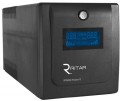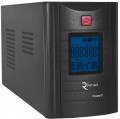Max. current
The maximum current drawn by the UPS. In fact, the current reaches its maximum value only when the UPS is operating from the mains with maximum load power and a completely discharged battery. However, when calculating the load on the power grid, this parameter should be taken into account.
Redundant sockets
The number of
outlets connected to the power reserve(battery) provided in the design of the UPS. In order for the UPS to fulfill its main role (providing a backup power in case of power outages), the corresponding electrical appliances must be connected to these outlets. The sockets have a standard shape and are compatible with the vast majority of popular 230 V plugs.
At a minimum, the UPS has
1 or
2 outlets and, in more advanced ones, there may be
3 or
more.
Non-redundant sockets
The number of
outlets without connection to the power reserve provided in the design of the UPS. For devices connected to such outlets, the UPS only performs the function of a surge protector — it smooths out small voltage irregularities; when the mains voltage fails, the power to these outlets is also turned off. The sockets have a standard shape and are compatible with the vast majority of popular 230 V plugs. The presence of sockets without a reserve allows you to connect equipment with different requirements for uninterrupted power supply to one UPS. For example, sockets with a reserve (see above) can include a system unit and a monitor, and a printer can be connected to a socket without a reserve. Thus, if the mains power fails, the computer will continue to work, allowing you to save data, and the printer will turn off, thus saving battery power and providing longer UPS runtime.
Fuse
Fuses are used to protect the UPS from a critical increase in current strength: at the right time, they open the circuit, preventing unpleasant consequences. Today, these types of fuses are used.
— Melting. At a critical current strength, the conductive element in such a fuse melts and opens the circuit. The fusible protection is disposable, after operation such a fuse must be replaced.
— Automatic. Such a fuse has a sensor that monitors the current strength and opens the contacts at the right time. Its main difference from fusible is reusability: after operation, the circuit can be closed again with literally one press of the button on the fuse.

